Chuck eye steak is often called the “poor man’s ribeye,” but that nickname doesn’t do it justice. Cut from just beside the ribeye, it shares the same rich marbling and big beef flavor for half the price.
Don’t confuse it with a regular chuck steak, though. The chuck eye comes from the first few inches of the chuck primal, right next to the ribeye, and is far more tender.
I like to grill this cut hot and fast, whether on charcoal, gas, or pellets. With the right prep and quick sear, you’ll get a tender, juicy steak that rivals any ribeye.
Why the chuck eye is your butcher’s favorite steak
- Ribeye-like flavor – Rich, beefy, and marbled enough to handle high heat and stay juicy.
- Quick and satisfying – Grilled hot and fast, it’s done in minutes without complex prep.
- Crust-ready surface – The fat content and muscle structure are ideal for building a crisp, flavorful crust.
- Forgiving on the grill – Slightly thicker and fattier than ribeye, it stays tender even if your timing’s not perfect.
- Budget-friendly upgrade – Delivers steakhouse flavor without the steakhouse price tag.
Ingredients you’ll need
- Chuck eye steak – I used a dry-aged chuck eye steak from Porter Road Butcher. You can find this cut from various online butcher stores or by checking with your local butcher. You won’t likely find this cut in your local grocery store.
- Homemade steak rub – This is our tried-and-true steak rub recipe. It’s the right balance of salt, pepper, and garlic to build a flavorful crust. It holds up to high heat without burning, while still letting the natural flavor of the steak shine through.
- High-heat cooking oil – I like avocado oil as a binder for the seasoning.
- Salted butter – This is optional during the resting stage, but it will enhance the flavor and presentation.
Equipment you’ll need
- Meat thermometer – I recommend an instant-read thermometer.
- Charcoal Grill – I used my tried-and-true Weber Kettle Grill, but any grill works.
- Charcoal – I used Jealous Devil Hardwood Charcoal. I don’t recommend using match-light charcoal.
- Charcoal chimney or torch – I am a little old school, so I use a charcoal chimney to start my charcoal. However, you can use a propane torch to get the charcoal going in the grill.
What is a chuck eye steak?
The chuck eye comes from the fifth rib, right beside the ribeye section (ribs six through twelve). It shares the same tender longissimus dorsi muscle that makes ribeye so juicy.
That location lends it some of the same marbling and tenderness, with a beefy depth more akin to a chuck roast.
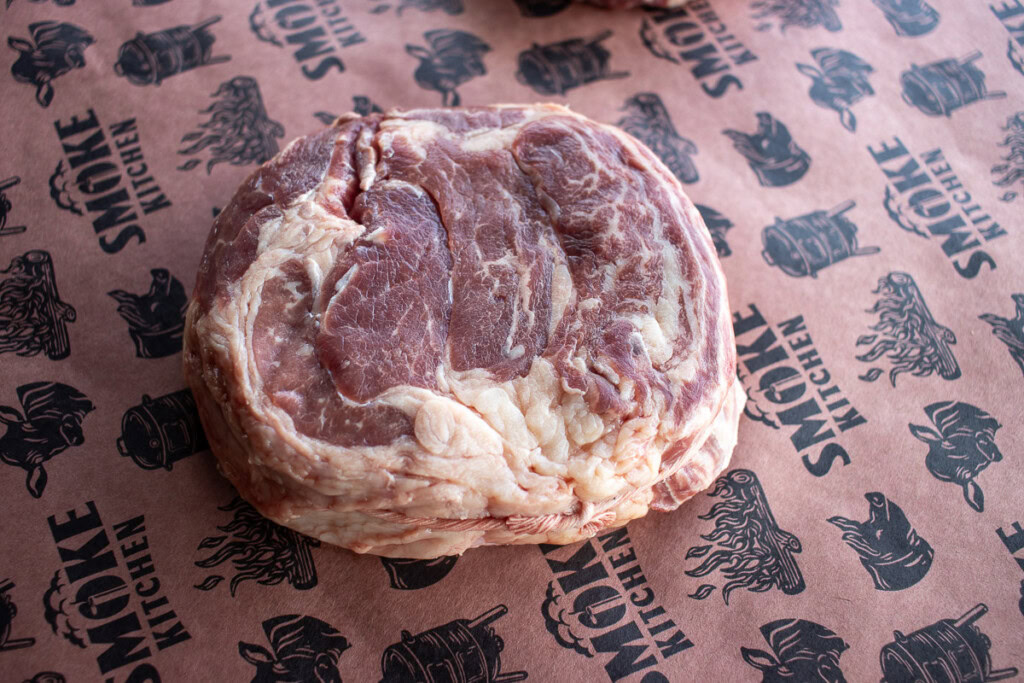
Slightly thicker and fattier than ribeye, it’s more forgiving on the grill and still delivers big flavor.
It’s often called the “poor man’s ribeye,” but that doesn’t do it justice. It’s rich, juicy, and affordable, if you can find it. There are only two chuck eye steaks per animal, so check with your butcher. They often keep them for themselves.
While you can grill a regular chuck steak, it’s better suited to slow cooking, like in our smoked pulled beef recipe.
If you’re after more budget-friendly cuts that still deliver steakhouse flavor, check out our guide to the best cheap steaks for grilling
Why grill hot and fast?
Through recipe testing and plenty of time behind the grill, I’ve found the hot and fast method works best for chuck eye steak.
Chuck eye has enough marbling to handle high heat and build a great crust, but it also has some fattier, tougher sections that benefit from a fast sear.
Grilling hot and fast helps that fat render without overcooking the meat, giving you a steak that’s juicy, beefy, and full of ribeye-like flavor.
How to grill a chuck eye steak
1. Season the steak
The key to this simple steak rub is the mix of coarse and fine black pepper with salt and granulated garlic. The coarse pepper adds bite, while the fine grind seasons the meat evenly for full, balanced flavor.
You can also use your favorite steak seasoning in place of our homemade rub recipe.
Make a bulk batch: If you want to make a batch of steak rub to store in the pantry, simply use a 1:1 ratio of salt and pepper, along with a 1 to 2 ratio of coarse pepper and garlic. For example, 2 tbsp each of both salt and pepper to 1 tbsp each of coarse pepper and granulated garlic.
Using oil as a binder, coat the steak evenly all over, being sure to hit the sides as well.
For the best result, salt the steak up to 24 hours in advance and let it rest uncovered in the fridge.
Most chuck eye steaks will come with butcher’s twine around the steak. The chuck eye steak has a lot of fat that renders while cooking, which can separate the different parts of the steak, so I like to keep it on while grilling.
2. Fire up the grill
I used a Weber Kettle for this cook, but any grill will work.
I get my briquets going by using a charcoal chimney, then dump them on one side of my Weber Kettle to create two heat zones: direct and indirect.
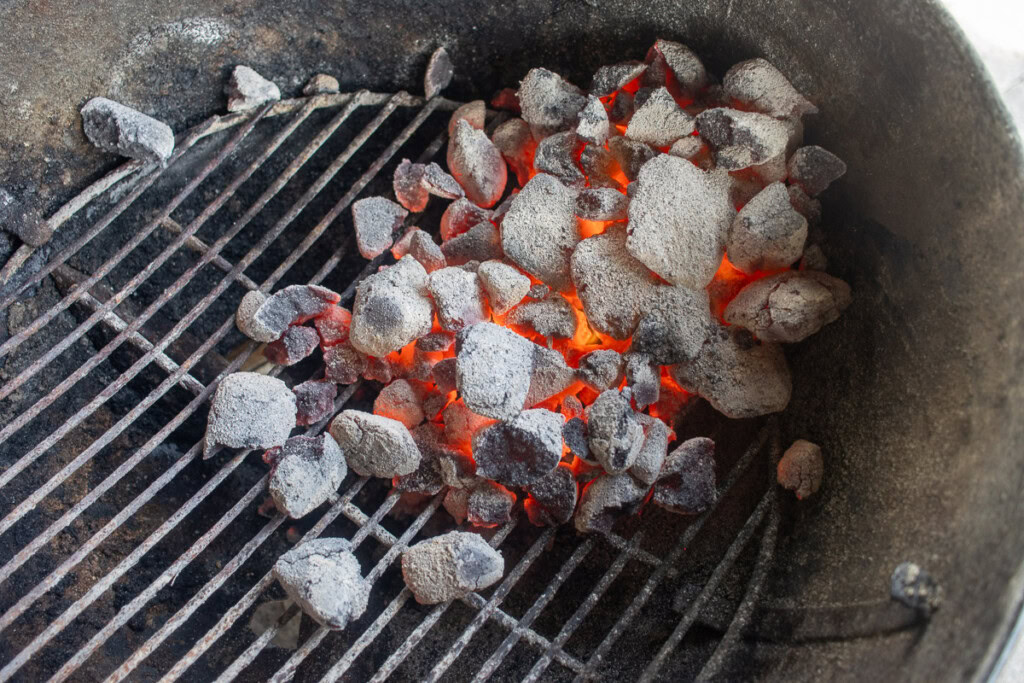
You can light the charcoal directly in the grill if you prefer, just let it burn until the coals ash over and turn white.
Pro tip – It’s vital that the coals are not too hot when grilling the steaks. If the coals are too hot, the fat dripping from the steaks will cause a flare-up, and the steaks will burn. If this starts to happen, quickly place the steaks on the opposite side to prevent them from overcooking.
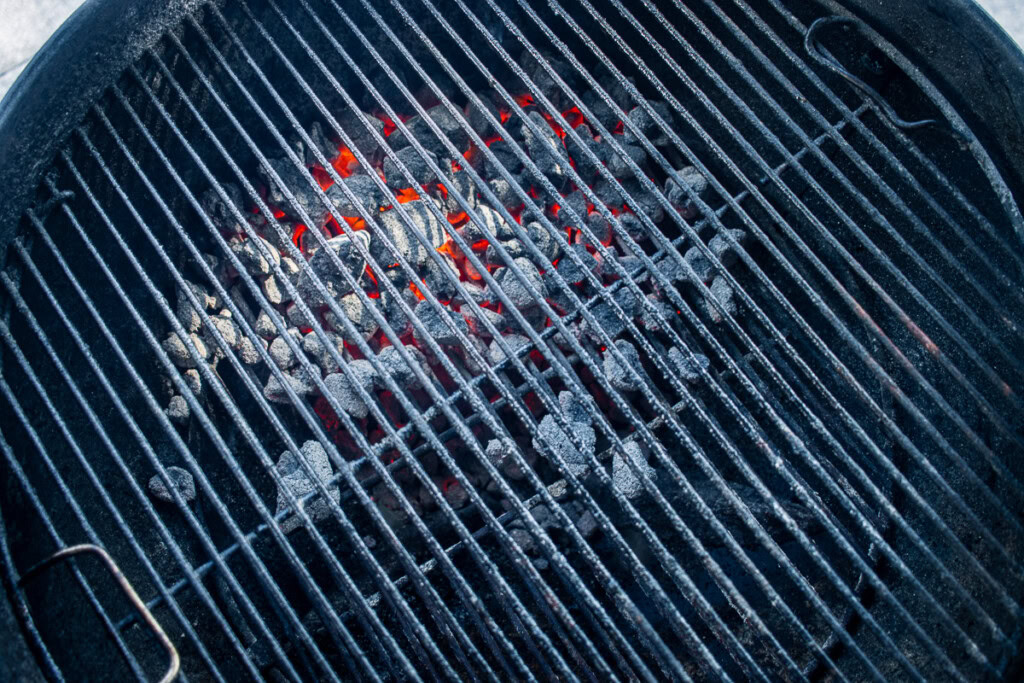
Having heat zones is key when cooking over live fire. It gives you control, lets you manage flare-ups, and provides a place to move the steak if things get too hot.
If you’re using a gas grill or griddle, aim for medium-high heat (around 350–375°F) and follow the same steps.
3. Grill the chuck eye steaks
Place the steak directly over the coals and grill for 90 seconds. Then flip and repeat (2 ½ minutes on each side, total) or until the internal temperature reaches 125°F.
Pro tip – Generally, when cooking hot and fast steaks, I like to flip the steaks every 30-45 seconds to build a nice crust, while keeping the steak evenly cooked. Given that this steak has butcher’s twine around it, I like to flip the steaks about every 90 seconds so that the steak can maintain its shape and prevent it from slipping out of the twine.
Place the item on the opposite side of the charcoal and rest for about 3-4 minutes, or until the temperature has increased to 130°F.
While in the resting phase, the steak will continue to rise to between 132°F and 135°F. Chuck eye steaks are at their best in terms of texture and flavor when served with an internal temperature of medium rare to medium.
4. Rest and slice
Move the steaks to a cutting board and place about a tablespoon of butter on each steak.
Rest for at least two minutes before slicing.
Slicing a chuck eye steak is different from traditional steak cuts because you do not need to worry about slicing against the grain.
It will slice similar to a ribeye, yet have a slightly different structure. The chuck eye will have an eye, a partial spinalis, multiple fat sections running throughout.
Slice the steaks into about ½-inch slices, and it’s ready to serve.
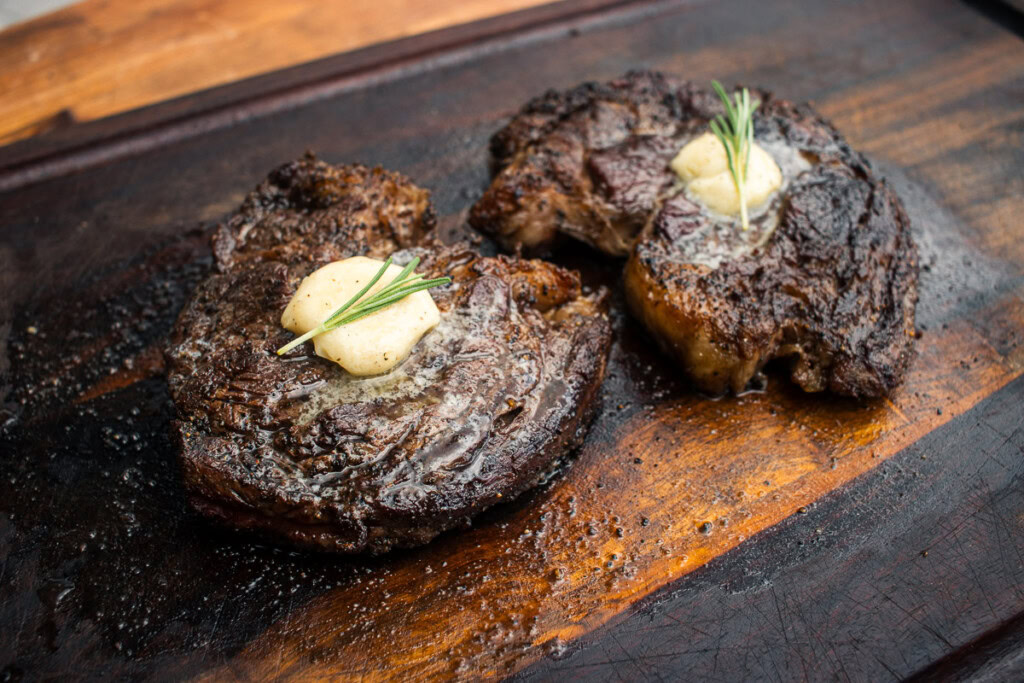
The butter is an optional step to add extra flavor and presentation.
Chuck eye steak might not have the name recognition of ribeye, but on the grill, it more than holds its own. With the proper prep and a hot fire, you get a rich, juicy steak that punches well above its price point. If you see this cut at your butcher, grab it; you won’t be disappointed.
If you manage to snag a chuck eye steak, we’d love to hear how it turned out. Drop a comment below, and don’t forget to leave a star rating.
Optional flavored butters for finishing
Top your steak with one of these simple compound butters to add even more flavor:
- Garlic herb butter – Softened butter mixed with minced garlic, chopped parsley, and a pinch of salt.
- Smoked paprika & lime butter – Butter blended with smoked paprika, lime zest, and a touch of chili powder.
- Blue cheese & chive butter – Crumbled blue cheese and finely chopped chives stirred into butter for a bold, tangy finish.
- Horseradish butter – Mix in prepared horseradish and a dash of black pepper for heat and richness.
- Maple bourbon butter – A small splash of bourbon and a dab of maple syrup mixed into butter for a subtle sweet and smoky twist.
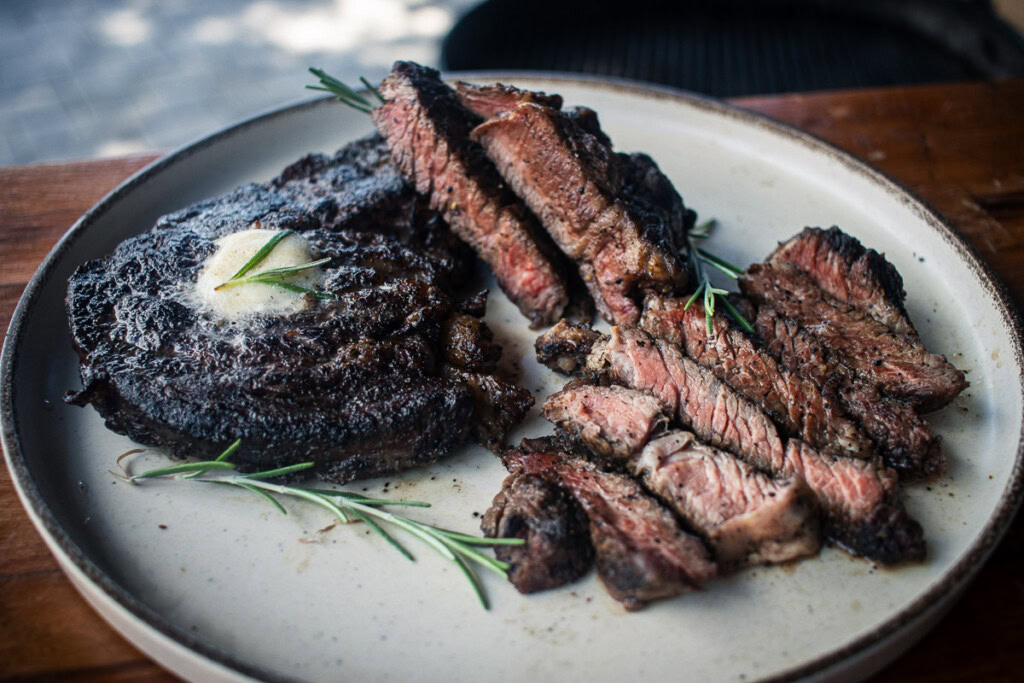
Sides to serve with steak
Print
Grilled Chuck Eye Steak (Ribeye Flavor on a Budget)
Chuck eye steaks grilled hot and fast over charcoal with a simple salt, pepper, and garlic rub. Tender, beefy, and packed with ribeye-style flavor.
Course Main Course
Cuisine American
Prep Time 5 minutes minutes
Cook Time 5 minutes minutes
Resting time 5 minutes minutes
Servings 2
Calories 109kcal
- 2 chuck eye steaks
- oil for a binder
- 2 tbsp butter
Steak Rub
- 1 tsp salt
- 1 tsp ground pepper
- ½ tsp course black pepper
- ½ tsp granulated garlic
Give each piece of steak a good coating of oil all over.
Season each steak with rub, making sure to get the sides as well.
Prepare your charcoal by lighting and reducing it down to a whiter coal. Place the charcoal on one side of your grill.
Place the chuck eye steaks directly over the coals and grill for 90 seconds, then flip and repeat (2 ½ minutes each side total) or until an internal temperature of 125°F. Then place them on the opposite side of the charcoal and rest for about 3-4 minutes or until the internal temperature has increased to 130°F.
Move the steaks to a cutting board, place a tablespoon of butter on each steak, and rest for at least two minutes before slicing.
Slice the steaks into about ½ inch slices and serve.
Twine – Most chuck eye steaks will come with butcher’s twine around the steak. The chuck eye steak has a lot of fat that will render while cooking, which will separate the different parts of the steak if grilled without the twine keeping them intact.
Grill temperature – It’s important that the coals are not too hot when grilling the steaks. If they are too hot, the fat dripping from the steaks will cause a flare-up, and the steaks will burn. If this starts to happen, quickly place the steaks on the opposite side to prevent them from overcooking.
Griddle or Gas – If you’re trying this recipe on a griddle or if you’re using a gas grill, you’ll want to cook around medium-high heat (around 350–375°F).
Slicing a chuck eye steak is different from traditional steak cuts because you do not need to worry about slicing against the grain. It will slice similarly to a ribeye, yet have a slightly different structure. The chuck eye will have an eye, a partial spinalis, and multiple fat sections running throughout. Calories: 109kcal | Carbohydrates: 2g | Protein: 1g | Fat: 12g | Saturated Fat: 7g | Polyunsaturated Fat: 0.5g | Monounsaturated Fat: 3g | Trans Fat: 0.5g | Cholesterol: 31mg | Sodium: 1166mg | Potassium: 36mg | Fiber: 0.5g | Sugar: 0.04g | Vitamin A: 358IU | Vitamin C: 0.01mg | Calcium: 11mg | Iron: 0.2mg
 Backyard GrillingWeekend WarriorsAdvice from DadBeard GroomingTV Shows for Guys4x4 Off-Road CarsMens FashionSports NewsAncient Archeology World NewsPrivacy PolicyTerms And Conditions
Backyard GrillingWeekend WarriorsAdvice from DadBeard GroomingTV Shows for Guys4x4 Off-Road CarsMens FashionSports NewsAncient Archeology World NewsPrivacy PolicyTerms And Conditions
